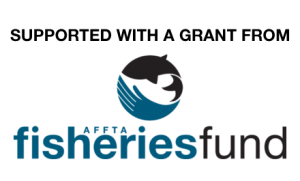Addressing Common Misconceptions About Stripers Forever
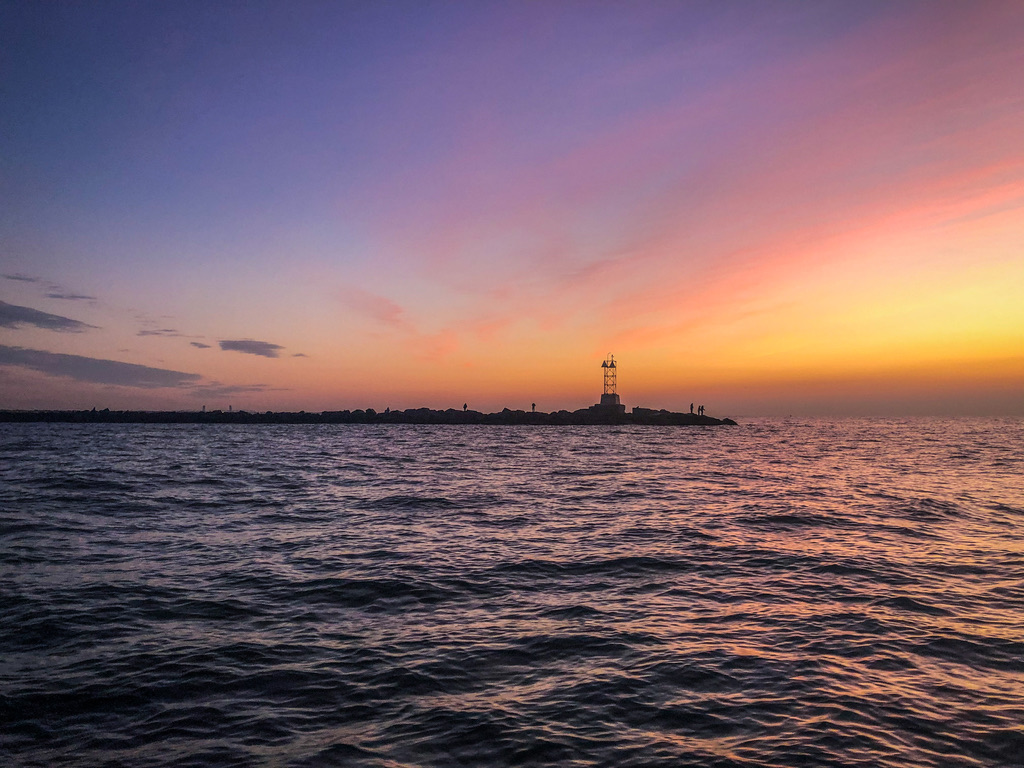
Photo- Taylor Vavra
Addressing Common Misconceptions About Stripers Forever
Mike Spinney | National Board Member
After more than twenty years involved in striped bass conservation (including before Stripers Forever was founded), I’ve learned to laugh at the ways our opponents attempt to discredit our efforts to effect a radical change in the way striped bass are managed. What choice do I have? During that time I have personally endured insults, threats, and lies about my character. I recall once while testifying at a public hearing on legislation Stripers Forever had worked to introduce before the Massachusetts legislature, one man made the ridiculous claim that if we were to succeed, he would be unable to have children.
Laughing at the absurdity doesn’t mean such mischaracterizations aren’t frustrating. Especially when they seem intentional; as a means of attacking the legitimacy of our organization and the credibility of the policies we believe hold the key to long-term recovery and abundance of wild striped bass. No policy or approach that Stripers Forever advocates is without successful precedent. Our critics know this, but they refuse to say so publicly.
Make it a Game Fish
Stripers Forever was founded in 2004 and from the start our motto has been “Make it a Game Fish.” This approach is commonly derided as a resource grab by a small group of “elitist” anglers who want all the fish for themselves, or as an attack on commercial fishing and the fishermen who target them. It is also implied that we believe game fish to be a magic bullet and that all fisheries managers need to do is to deny the commercial fleet access to striped bass and all will be fine.
Truth is, designating striped bass as a game fish is merely a tool to give fisheries managers the means to make better decisions without having to address the conflicting goals of trying to balance abundance and “maximum sustainable yield” or MSY. Once a species is protected as a game fish, regulations such as size and bag limits can be quickly adopted to ensure a single goal is achieved. To deny that this is the case is to deny history.
Redfish are one of the most popular game fish along the U.S. Gulf Coast. Well regarded as table fare, they were also targeted as a commercial resource. Much like striped bass, most redfish were harvested by recreational anglers, but the conflict of managing for both abundance and MSY saw redfish in steep decline until efforts by recreational fishing groups saw redfish declared a game fish, starting with Texas in 1981 and eventually coastwide. Since then, and with a singular management focus, redfish have flourished, growing to wide abundance and generating a robust recreational economy. In fact, in dollar value, redfish are the country’s top saltwater sport species generating more than $4.8 billion in economic activity per year.
Recognizing the overwhelming value of an abundant economic fishery, species like tarpon, bonefish, and snook are also protected and managed exclusively as game fish. If striped bass were afforded game fish status and the population were to return to post-moratorium abundance, it is estimated they would be the focus of a recreational angling economy worth more than $6 billion.
When We Say Moratorium
During the initial public comment period in the lead-up to the Atlantic States Marine Fisheries Commission’s (ASMFC) draft and adoption of Amendment 7 to the Interstate Fishery Management Plan for Atlantic Striped Bass, stripers forever generated a lot of attention when we called for a ten-year harvest moratorium for striped bass. Throngs of anglers, frustrated with decades of ASMFC failure, rallied to the cause while our critics howled with outrage—and distortions.
They claimed we wanted the fishery shut down completely for ten years, but that is not what a harvest moratorium means—and they know it. A harvest moratorium would allow angling for striped bass to continue on a catch-and-release basis, which already constitutes the majority of recreational angling for stripers. But recreational anglers account for most fishing mortality, they claim, so nothing will change. Fish will still die!
What will change is that 100% of the coastal commercial quota—nearly two million pounds of breeding sized female fish—will remain in the water, alive, and able to return to the Chesapeake Bay and Hudson and Delaware Rivers to spawn. This is a vital component to any recovery plan. You need big, mature females to reproduce and keep new generations of fish in the pipeline. Looking at the results of the Chesapeake Bay young-of-year surveys since 2012, six were de facto failures (including the worst year on record), two were below average, and three were just above average. That does not bode well for the future.
(It’s worth noting that the strong 2011 year class disappeared and that the ASMFC admitted it failed to act fast enough to protect the 2015 year class. Given concerns over warming oceans and inconsistent water quality in the vital Chesapeake nursery areas, there are too many variables to risk focusing a commercial fishery on fecund female fish.)
And as with our position on game fish, the idea of a harvest moratorium is not without a successful precedent. Even though the moratorium that was imposed in 1985 after striped bass stocks collapsed was not coastwide, it was enough to relieve pressure on striped bass—especially in Chesapeake Bay. As a result, striped bass rebounded and produced strong spawns in 1989, 1993, and 1996. The ASMFC declared striped bass “recovered” in 1995 and resumed active monitoring of the species. Ironically, striped bass have been in steady decline ever since.
We Remain Steadfast
Today, Stripers Forever remains steadfast in our belief that the best path to recovery for striped bass begins with game fish designation, at which point common sense management protocols designed to encourage species abundance can be implemented. These policies are already supported by an overwhelming majority of the 300,000 strong recreational angling community who recognize that effective fisheries management often requires sacrifice. How can you characterize as selfish so many who have, for years, demanded more restrictions on themselves even as the commercial fishing lobby keep asking for permission to kill more fish?
Rest assured, Stripers Forever will continue to fight for the recovery of striped bass. We will continue to be a voice for those anglers who want to see a healthy, abundant striped bass population that they, their children, and their children’s children can enjoy for generations to come.
Thank you for your continued support!
ASMFC Winter Meeting Summary – Addendum 1: Commercial Quota Transfers
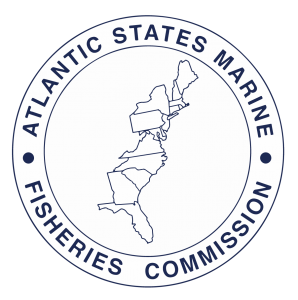
ASMFC Winter Meeting Summary – Addendum 1: Commercial Quota Transfers
Taylor Vavra | Vice President
We asked you to step up and be part of the process on Addendum 1, you did in a big way. After sending in written comments and eight public hearings, over 98% of comments supported Option A (Status Quo) – Transfers not permitted. Unfortunately on Tuesday January 31st the ASMFC Striped Bass management board choose to completely ignore our collective voice. This was not the first time and unfortunately it likely won’t be the last. Ultimately the board elected to postpone action on Addendum 1 until May. They have tasked the technical committee (TC) with further analysis and projections on how commercial transfers might affect the stock and rebuilding plan. To say that we were disappointed with this result would be a major understatement.
The meeting started out with a summary of Addendum 1, the options available to the board and eventually the results of the public comment period. It remains unfathomable, but that would be the last mention of those results for the remainder of the meeting. Not one board member recognized the overwhelming support for Option A and the desires of the public to prioritize the rebuilding of the stock over maximizing commercial harvest. It is an embarrassment to the ASMFC that Addendum 1 is even being discussed as the stock is currently over overfished and supposedly in the process of rebuilding. Aside from Option A, this addendum does nothing but jeopardize the large breeders that make up the spawning stock biomass (SSB). Whether or not the TC estimates support that, the board should be playing it safe and remain solely focused on protecting the SSB and rebuilding the stock.


It was no surprise that John Clark, Delaware’s fishery manager, started off by making the motion that the board approve Option D. His general argument being that it was the most conservative option available. He knew that this would be the best shot at getting Delaware the increase in commercial quota which they have long desired. This was not how we had hoped the discussion would begin. It remains unclear how many votes this motion would have received because soon after Dr. Jason McNamee, Rhode Island’s fishery manager, provided a substitute motion. Seconded by Dr. Justin Davis, Connecticut’s fishery manager.
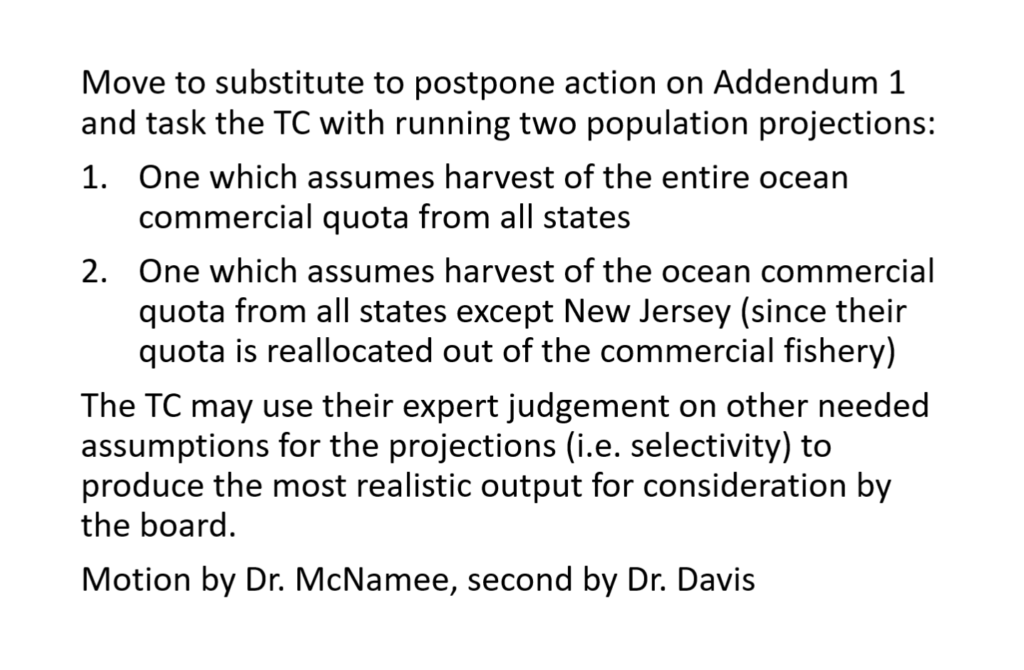

We are not against having as much information as possible to make an important decision but in this case it might have been a good idea to have done this prior to asking for public input. When the data becomes available in May, it was made clear that the board can act on it without public input. It feels as though it was a colossal waste of time holding the hearings and gathering written comment when it was completely ignored and we will not be given a second chance to weigh in on this. In addition to that, it has also become clear that this works in the favor of those who would like to see commercial quota transfers approved. Most likely the TC will find that this increase will be minimal in comparison to the 2022 recreational landings data (MRIP) which will also be available at that time.
But the expectation is that 2022 recreational landings combined with catch and release mortality will be greater than 2021. Those numbers could have a big impact on the rebuilding plan and possibly indicate that the stock will not rebuild by the 2029 deadline. If so, it could in fact force the board to initiate a new management action to get back on track and meet the deadline for rebuilding. Whether or not that comes in the way of a moratorium of other reductions in F (fishing mortality) remains unknown. The bottom line is, the future of the stock continues to exist in a cloud of uncertainty under the management of the ASMFC.
The motion to postpone passed with a 15-1-0-0 vote. I feel like a broken record in saying, they’ve done it again, kicking the pro-verbal can down the road. The board asked for public input and we gave it to them in form of overwhelming support for Option A (status quo) – no commercial quota transfers. It was their responsibility to take action, one way or another, they choose to leave this issue unresolved. Two parties pay the price for that, the angling public and Striped Bass. This was an unfortunate turn of events and we are saddened by having to report back with the news. Rest assured, we will stay on top of this and be there when MRIP data the the TC projections are made public. Stay tuned!
Thank you for your continued support!
ADDITIONAL LINKS
- Atlantic Striped Bass Board Winter Meeting- Meeting Summary (PDF)
- Atlantic Striped Bass Board Winter Meeting- Presentation Slides (PDF)
- Atlantic Striped Bass Board Winter Meeting- Presentation Audio/Video (YouTube)
ASMFC Nov. Meeting Summary & ACTION ALERT- Addendum 1: Commercial Quota Transfers




ACTION ALERT
PUBLIC COMMENTS DUE BY JANUARY 13, 2023
ASMFC Nov. Meeting Summary & Addendum 1: Commercial Quota Transfers
Taylor Vavra | Vice President
Let’s begin with a quick summary of the important takeaways from the November 80th Annual meeting of the Striped Bass Management Board.
We were pretty surprised when the stock assessment update was released ahead of the November ASMFC meeting and it indicated that the stock is overfished but that overfishing was not occurring. So the SSB (spawning stock biomass) is below both the target and threshold but F (fishing mortality) is also below both the target and threshold. To put it simply, according to the update, our large spawners are still in trouble but overall we are killing fewer fish. Based on that and other data being considered, the stock assessment update states that Striped Bass have a 78.65% chance of being above the target by 2029. Seemed like pretty good odds and initially we were very happy to hear this.
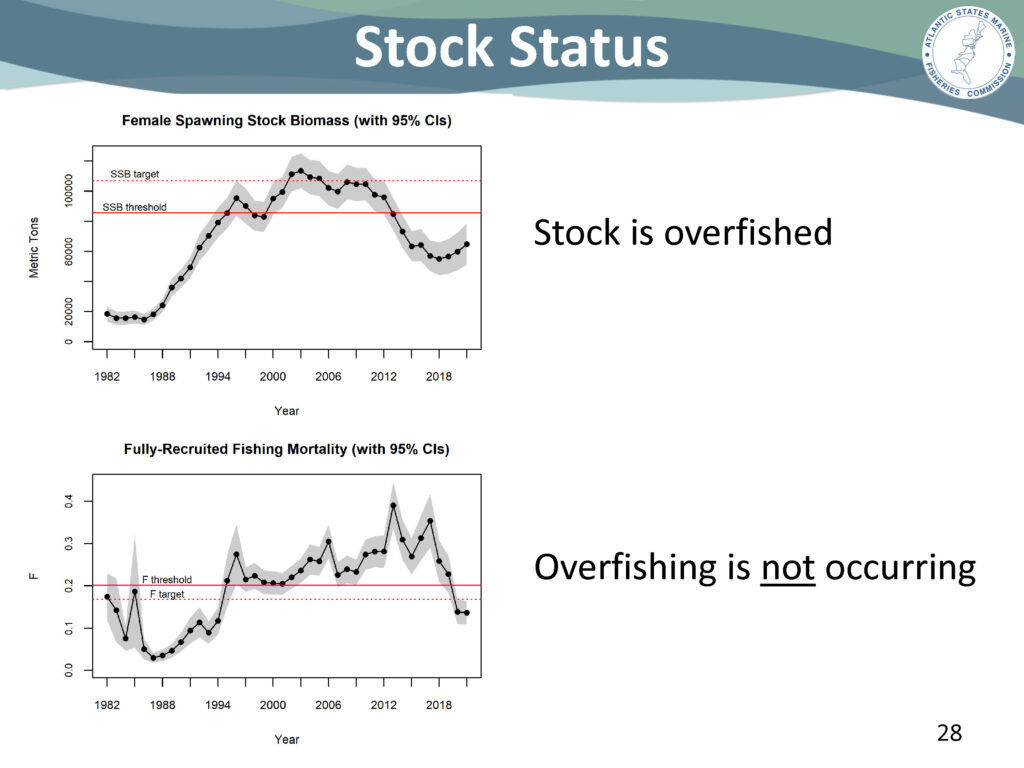
Then came the meeting on November 7th and the presentation of the stock assessment update. It soon became clear that things were not as positive as that 78.65% chance had first indicated. The percent chance of getting SSB above the threshold and target hinges on F (fishing mortality), this is to be expected. It should be understood that F (fishing mortality) directly correlates with effort, the number of anglers targeting Striped Bass. The greater the effort, the more fishing mortality. While effort and F can be estimated or forecasted for future years, there really is no way to know exactly what that number will be. Looking at commercial landing/discard and recreational landing/release mortality charts you will see that almost no two years are the same.
As you can see in the series of graphs and chart below, only the slightest change in F greatly reduces the percent chance of bringing the SSB above the threshold and target. When I say a slight change, we are talking about F changing from 0.1363 to 0.2013, resulting in a dramatic change in the percentage chance of getting the SSB above the threshold and target. We quickly go from a 96.7% probability of getting the SSB above the threshold to 59.4%. The probability of getting the SSB above the target goes from roughly 78.6% to a scary 30.5%.
Mike Armstrong of MA said the following directly after the stock assessment update presentation, “The projections seem really sensitive to F, which you know, is a no brainer. But, we’re talking about operating in the hundredths place and a few point change there really changes the course of how we recover. I conclude with, its just this board should be very cautious, cause it doesn’t take a lot to change the course of the recovery. A very relatively minor rise in F will put us back in the recovery period.” We applaud Mr. Armstrong on his conservation minded approach and strong words for the board as things move forward. Unfortunately the reality of this situation is that it may be too little, too late.
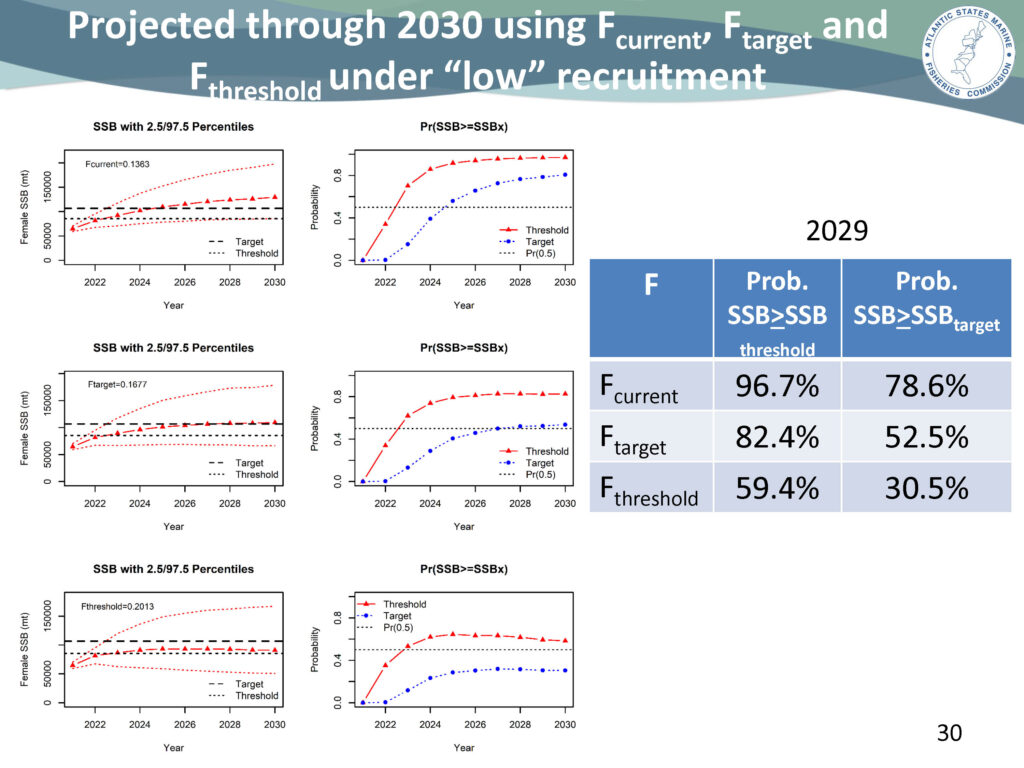

Following Mr. Armstrong some more questions and comments were taken. Here is where we have a little bit of good news. Emerson Hasbrouck of New York, jumping off Mr. Armstrong’s previously quoted comments, asked to put some guardrails on F. “So, if the retrospective pattern is showing, or is telling us that we tend to over estimate SSB and underestimate F, we are getting close to being on the razor’s edge here.” He went on to ask if the board was going to get another update on F next year or if it would be the usual 2 years. Mr. Hasbrouck then asked for an interim update to see where things are so that if needed the board to make adjustments to the management plan to try and stay on track with the rebuilding. This was the most positive aspect of what was otherwise a very disappointing meeting.
So how did we get to this point and why didn’t the ASMFC take more aggressive preventative steps in recovering the stock? The ASMFC has a long track record of mismanagement, let’s not forget that it was their actions, or lack thereof, that put us in this position. The writing was on the wall for years prior to the board even acknowledging there was a problem with the stock. Then came the years-long delay in getting management plan in place. While we cannot fully explain why things are this way we can certainly say that we made our best attempt to pursue and support a simpler plan in the way of an equitable commercial and recreational harvest moratorium. This coupled with required angler education on best practices for catch and release would have given the stock the best chance at recovery.
While we will not deny that recreational catch and release plays a significant part in F we cannot be blind to the fact that the commercial sector is largely targeting and harvesting breeders (SSB) over 35″. So currently the ‘slot’ really only applies to the recreational sector while the commercial sector continues to decimate to the spawning stock biomass (SSB) which is already in trouble. On top of all that, we have had four straight years of very bad recruitment in the Chesapeake. Maybe I am wrong but at the moment it seems hard to find any positive news coming out of the ASMFC and we have not even gotten to the good part yet. (Read on below)
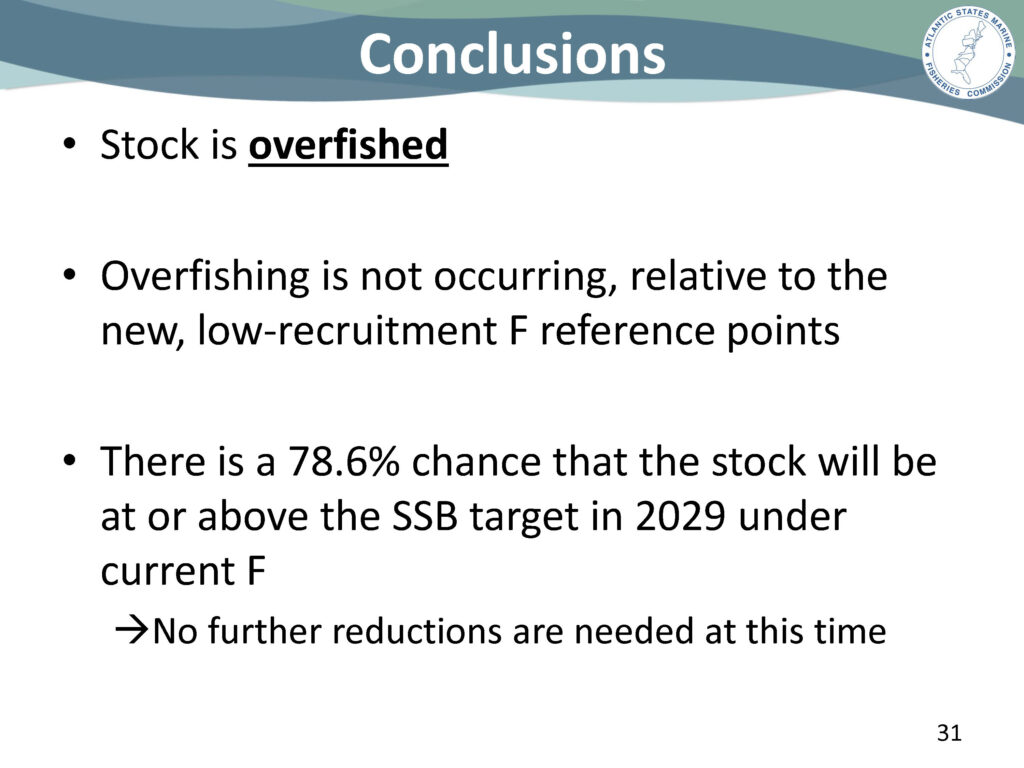

Based on this so-called 78.6% chance that the stock will be at or above the SSB target in 2029 no further reductions are needed at this time. While, as stated earlier, we would have liked to have seen a more aggressive and preventative approach to come out of Amendment 7, this seemed to be expected. Entering from stage left…conservation equivalency (CE). To our surprise and horror, this conclusion of no further reductions needed, meant way more than we ever could have imagined. A technicality or accurately a loophole in Amendment 7, means that states can continue to make use of CE in 2023. How could this be? There was over 98% agreement amongst the public and conservation organizations that CE has no place in the management of an overfished stock currently experiencing overfishing. Is it a surprise that the ASMFC has yet again failed to recognize the public’s outcry to take CE off the table? Unfortunately not. This has become standard practice for the ASMFC and the management board, it has come to be expected.
And unfortunately that is not the the end of the story. Aside from what we would call a massively misleading figure with regards to rebuilding probability and the loophole of CE emerging from the grave, the board is now considering Addendum 1 to Amendment 7, commercial quota transfers. In one of the most ill timed and astonishing moves the board is actually considering maximizing commercial harvest in the midst of the rebuilding of a stock that not long was considered both overfished and experiencing overfishing. This Addendum runs contrary to nearly everything conservation organizations and the public wants. How it even saw the light of day at a time like this remains unexplainable.
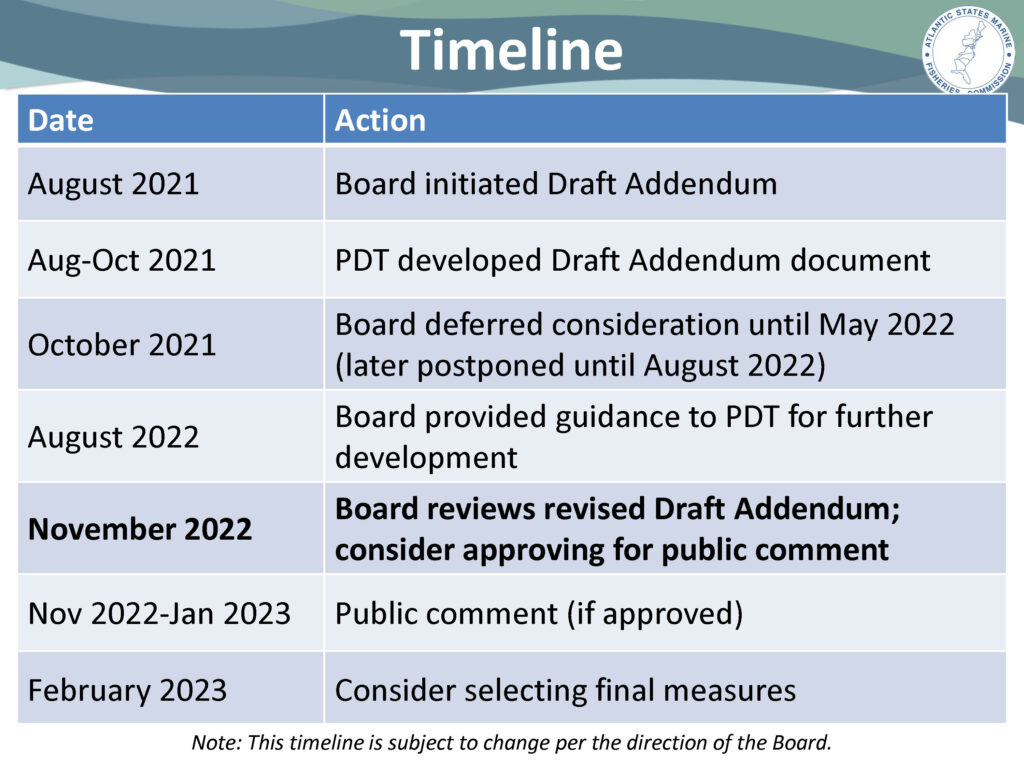

We are not going to get into extreme detail on this, quite frankly it doesn’t deserve it. Here is the simple truth; for years now the ocean commercial quota has not been fully met and usually rests somewhere around 65%. If Addendum 1 were to be approved states would do everything they could to grab unused quota and harvest more Striped Bass, most importantly and as we discussed earlier, breeder sized fish 35″ and bigger. This would do further damage to an already unstable SSB during a time of poor recruitment. The impact that this would have on the rebuilding plan is unclear but it would be safe to assume that this would work directly against it.
So, yet again, we ask that our supporters be part of the process and make your voices heard. Take a few moments to write your comments and send them off to the ASMFC. Let them know that there is no place for such an addendum while the Striped Bass stock is recovering and rebuilding. Below is the info you will need to do so. There is only one option to support, Option A (status quo): Commercial quota transfers are not permitted. Below you will also find a list of the remaining scheduled hearings. You do not have to be a resident of a given state to attend in person or online and give your comments. We do suggest that either way you email your comments, the more comments received by the ASMFC, the more likely this addendum never sees the light of day.
Thank you for your continued support!
Link to Addendum 1 to Amendment 7: DRAFT ADDENDUM I TO AMENDMENT 7
Email: comments@asmfc.org
Subject Line: Striped Bass Addendum I
Support: Option A (status quo): Commercial quota transfers are not permitted.
Comments will be accepted until January 13, 2023 at 11:59 p.m. (EST).
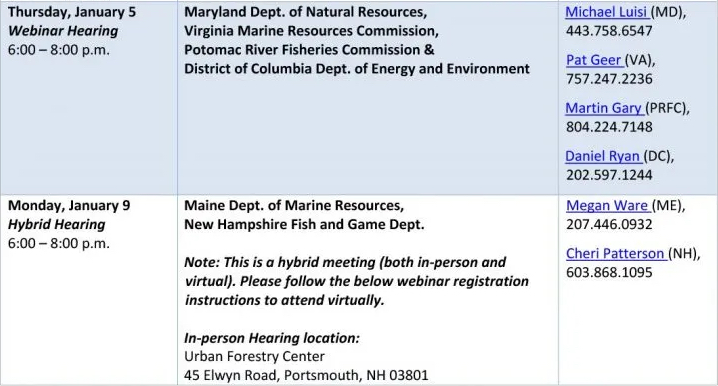

ADDITIONAL LINKS
- Atlantic Striped Bass Board 80th Annual Meeting- Presentation Slides (PDF)
- Atlantic Striped Bass Board 80th Annual Meeting- Presentation Audio/Video (YouTube)
ASMFC 80th Annual Meeting (11/7/22), Stock Assessment Update & MD YOY Report




ASMFC 80th Annual Meeting of the Atlantic Striped Bass Management Board
To register for the live webinar please go here: ASMFC 80th Annual Meeting- Striped Bass Management Board (GoToMeeting Webinar ID: 153-669-435)
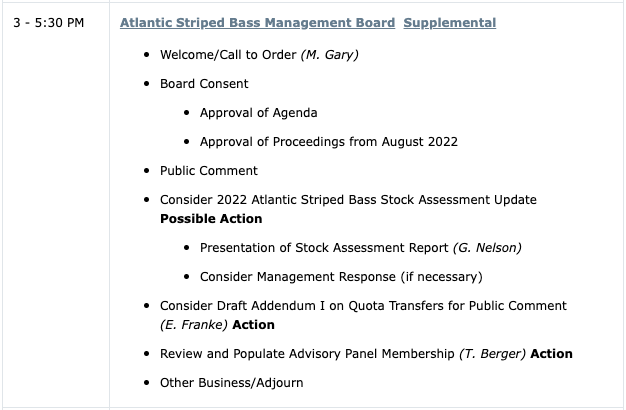

ADDITIONAL LINKS
- Atlantic Striped Bass Board- Draft Agenda/ Meeting Overview/ Main Meeting Materials
- Atlantic Striped Bass Board- Supplemental Materials
ASMFC 2022 Stock Assessment Update
On October 26th, ahead of the 80th annual meeting, the 2022 stock assessment update was released. While there is some good news, it is important to look a the big picture before anyone begins to celebrate. We were fully expecting some bad news from this update and are now equally alarmed at the idea that things seem to be turning around. As you will see in the two charts below the update now states that the stock is no longer experiencing overfishing. The fishing mortality rate (F) is now at a level below both the target (dashed line) and threshold (red line), overall there were less fish being killed in 2021. You could point to a number of reasons for this but most likely the main reason being reduced effort.
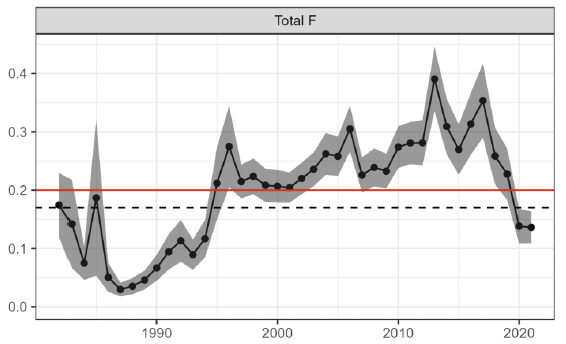

On the flip side, the stock is still overfished, the SSB (spawning stock biomass) is well below the threshold reference point (red line).
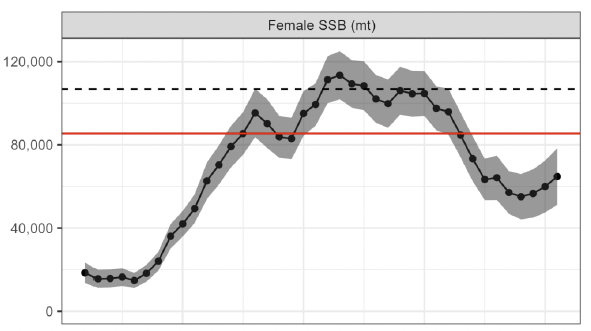

As you can see in the chart it does appear that the SSB is headed in the right direction, maybe the slot is working? Either way it appears we have a few more years before the stock is no longer overfished. Several of the strong year classes will soon be within the slot and that could easily push the SSB back in the wrong direction coming out of four straight years of poor recruitment.


The stock assessment update is projecting a 78.65% chance of the stock being rebuilt by 2029 if fishing mortality (F) remains the same. Based on this, the assessment states that there is currently no need for a reduction in catch. While that is a high percentage, what happens if effort and in turn fishing mortality increases in the coming years? In conjunction with poor recruitment (young-of-year) there is a good possibility that the ASMFC is setting itself up for disaster. This is when we return to our belief that a coast-wide recreational and commercial harvest moratorium is the most fool-proof way to rebuild this stock. While many point towards recreational catch and release mortality as a driving cause for the current condition of the stock, 9% of those fish will not survive as opposed to 100% of those harvested. Based on NOAA data, in 2021 3.5 million pounds of Striped Bass were removed (harvested) by the commercial sector and 15.8 million pounds on the recreational side. So if a harvest moratorium were put in place, each year roughly 20 million pounds of Striped Bass would remain alive. With all the ifs, ands and buts surrounding this assessment and the management of the stock by the ASMFC we still believe that a temporary coast-wide recreational and commercial harvest moratorium would be the best option at this point in time. Unfortunately there is very little likelihood of that or any other reduction happening based on this stock assessment update.
In addition to these uncertainties, in a blog post on Nov. 5th, the folks at ASGA brought to light some very upsetting news regarding CE (conservation equivalency). To quickly summarize, because management measures are not going to change (stock assessment update) it is possible that both Maryland and NJ could continue to use CE. There was nearly complete agreement amongst organizations and the public on the removal of CE during the Amendment 7 process. The fact that it remains a question only leads to more mistrust in the ASMFC and their ability to manage Striped Bass back to abundance. We urge you to read their blog post and immediately email your states commissioner and ask that they keep CE fully off the table until the stock not experiencing overfishing and is not overfished.
MDDNR 2022 YOY (young-of-year) Survey Results
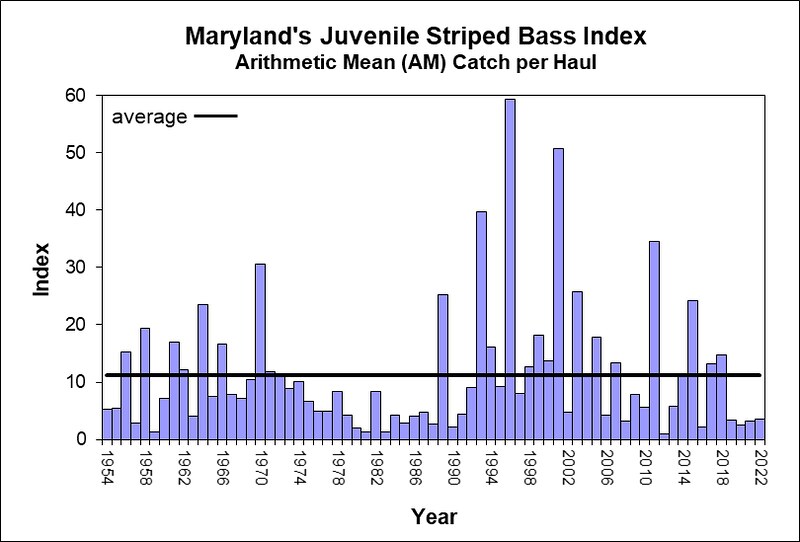

Unfortunately the Maryland DNR 2022 young-of-year survey has brought more bad news to the table. The juvenile Striped Bass index is dangerously low for a forth consecutive year. This lack of good recruitment is not good and could have long term implications even if the stock is rebuilt by 2029. Rebuilding the stock is wonderful as long as we have fish entering the system and growing to spawning size. While it seems that spawning in VA and NY has been better than normal, the Chesapeake is a primary spawning area for Striped Bass and without it there is yet again more uncertainty around the future of Striped Bass, rebuilt stock or not.

